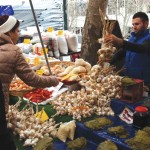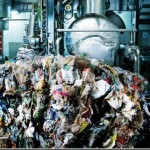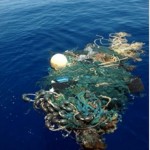Introduction
On one level, the new EEA Signals report, Well-being and the environment, is not new material but rather the EEA adding its voice to the growing chorus of international, national, and local organizations arguing for the adoption of a green economy. Yet the report does what EEA does best: it takes on a central issue and presents it in imaginative, verbally-accessible and graphically interesting ways. For that, it is worth reading and disseminating.
The basic premise of the report is not a pretty picture. We use natural resources faster than the planet can replenish them, we turn these resources into products that harm the planet and us, and we either waste or discard the products after a brief period. And then we start all over by extracting more natural resources to replace the discarded goods and services and products. It is all a vicious circle.
We‘re doing all of this at an unprecedented scale and time period. Each of us consumes about 3 times as much energy and twice as many materials as our ancestors did in 1900, and there are 7.2 billion of us now and there were only 1.6 billion back in 1900. And we’re expecting another several billion by 2050.
The Framework
To stop this mad rush to a barren planet, the EEA offers a “green economy” which the EEA defines as “an economy where society uses resources efficiently, enhancing human well-being in an inclusive society, while maintaining the natural systems that sustain us.” At 10. It sounds and looks a lot like “sustainable development.”
The bottom line is that we need to produce more with less input. We can do this by closing the circle, with everything getting re-used, recycled or recovered, and re-designed to eliminate wastage. To reduce the rate of new extraction and amount of waste, consumers and producers need to engage in “collaborative consumption.” The collaboration is between the consumer and producer in an attempt to provide consumers with goods and services without the consumers buying anything. Instead, businesses provide the services that products provide through leasing, sharing and similar arrangements. Borrowing tools from a neighbor is a simplistic example; car sharing is a more modern and expansive example. Other possibilities include leasing electronic devices and even making use of clothes libraries to borrow clothes. Of course, the spread of the internet and social media enables this collaborative consumption, as in use of apps for car sharing.
To implement such a green economy, the EEA report indicates that we need to focus on entire systems, not just specific sectors of the economy and society. For instance, a thoughtful energy policy must address the entire energy system including: all the types of energy available (coal, wind, solar, gas, etc); all the ways we extract this energy (wind turbines, oil/gas wells, etc); where we use it all (homes, transport, industry, farming); and how we distribute it.
Applications
After laying the foundation for its report, the EEA builds several case studies that focus on the global food system, waste system, and litter in our seas. The report also includes an interview on “What makes us buy what we buy?”, focusing on how buying is less rational or cognitive based than previously thought, and that more likely we buy what we know, including what others around us buy. The other interview, “How to make cities ‘green’,” focuses on ways of getting politicians and businesses to commit to long-term planning for cities where 75% of Europeans live. We will concentrate on the case studies.
Food System
To exemplify its focus on entire systems, rather than sectors, the EEA report provides a case study of the food system that includes producing, processing, packaging, transporting, and distributing food. Each step uses resources and generates waste and pollution. Production requires inputs of seeds, feed, fertilizers, and use of machinery, water and land. The water used produces wastewater, fertilizers and pesticides discharge into soil and water, and food packaging becomes waste. Distribution requires transport and use of fossil fuels by producers, distributors and consumers. Consumers prepare and consume food, using energy and disposing of food and packaging waste.
Agricultural productivity has increased so that Europe is using less land to produce more food. This production change has led to elevated levels of pollution in the air, rivers, and soil.
European agriculture accounts for 90% of ammonia emissions, 50-80% of nitrogen loading to freshwaters, and 10% of greenhouse gas (GHG) emissions, including 80% of methane emissions. In Ireland, agriculture accounts for about 30% of GHG emissions.
The amount of food waste is also on the rise. One-third of food produced in Europe is wasted though still suitable for human consumption. Food is also wasted during the production and service phase of the food system.
The food system remains a critical source of income and stability for many local communities, so the question is what can be done to improve this system. The primary improvement in production would be sustainable farming using less or no fertilizers and pesticides. At the transport, retail, and consumption stages, there are ways to increase efficiency. Eating less meat and more vegetables, for example, eases pressure on land use. Europeans eat more than twice as much meat per person compared to 50 years ago, although since 1995 meat consumption has declined by 10%. Europeans also are eating more poultry, fish, fruits and vegetables so there is improvement here.
As for reducing food waste, consumers can be more careful in buying and preparing only the amount of food that is necessary, and they can be more creative with any leftovers. Being realistic about “best before” dates would also help, recognising that food does not go bad in one day.
If we reduce the amount of food we waste, the entire system is strengthened. Less food waste leads to less water usage, less fertilizers, less land use, less transport, less energy usage and less recycling required. This is the circular economy in positive mode.
Waste
Europeans produce 481 kg of municipal waste each year and the amount of waste is linked to production and consumption. More products entering the market (think of electronic devices), and more one-person households lead to more waste. Indeed, electrical and electronic equipment represent the fastest growing form of waste, which is estimated to reach 12 million tonnes by 2020.
EU legislation is critical to reducing waste and some countries are adding hefty landfill taxes and extending producer responsibility for managing reuse or recycling of end-of-life products. Improvement is seen in the increase in municipal waste being recycled, going from 31% in 2004 to 41% in 2012. In Ireland it is 44% and in the UK it is 46%. In addition, kitchen and gardening waste, the biggest part of municipal solid waste, can be collected separately and converted into energy or fertilizer.
Once again, sustainable practices like recycling strengthen the circular economy as recycled materials replace new materials reducing extraction and production inputs. If products are wasted, so are the labor, land, energy and other inputs used in extracting, producing, distributing and consuming the products. See Update (3 July 2014) below.
Litter in the Seas
In an earlier issue of this magazine, we published a Report on sea litter in Ireland and the EU, but the EEA report includes some recent data that is useful to focus on.
One of the pervasive forms of sea litter is plastic and since the start of its mass production in the 1950s the volume of plastic produced has risen 1.5 million tones each year and now totals 280 tonnes each year. While sunlight, salt water and waves degrade plastics to a degree, smaller pieces of plastic remain in large volumes. As an example of its persistence, plastic bottles can take 500 years to degrade into microscopic but still present pieces. As a result, we find that 90% of dead sea birds from the North Sea have plastic in their stomachs.
Coastal communities are most affected by visible debris and in the UK municipalities spend about £18 million per year on beach clean-ups, and these actions miss the smaller pieces of plastic. Moreover, only 15% of plastics float on sea surface (and reach land), while 15% is found in the water column, and 70% rests on sea beds, where it can be ingested by marine species.
An Taisce recently reported that more than half-a-million pieces of litter were collected from the Irish coastline last year, with 80% of the litter coming from land-based activities.
Since 80% of marine litter comes from land activities, the EEA report discusses prevention on land through reducing packaging waste, increasing recycling, especially of plastics, improving wastewater treatment systems, and even using “fishing for litter” where boats collect marine litter much like trash trucks on land.
The EEA has developed “Marine Litter Watch”, which is an app to monitor Europe’s beaches for litter, collect data, provide information on clean-up initiatives nearby, and to help build a community of concerned citizens. In its report, An Taisce urged sun bathers to spend two minutes picking up litter, taking a photo of it on their mobile phone, and sharing it on Facebook and Twitter with the hashtag #twominutebeachclean. Newer technologies are increasingly being used to combat environmental pollution.
Sources
EEA Signals 2014 – Well-being and the environment: Building a resource-efficient and circular economy in Europe (03 June 2014). www.eea.europa.eu/highlights/signals-2014-our-well-being
Fiona Harvey, “Quarter of UK’s food thrown away ‘untouched’, waste figures show,” The Guardian (24 June 2014). www.theguardian.com/environment/2014/jun/24/quarter-of-food-thrown-away-untouched-waste-figures-show
“Marine Litter/Waste: What the EU, Northern Ireland and Republic of Ireland Are Doing, and Not Doing, About It,” irish environment (October 2013). www.irishenvironment.com/reports/marine-litterwaste-what-the-eu-northern-ireland-and-republic-of-ireland-are-doing-and-not-doing-about-it/
“Sun lovers urged to combat scourge of litter on beaches,” Irish Independent (21 June 2014) – An Taisce study www.independent.ie/irish-news/news/sun-lovers-urged-to-combat-scourge-of-litter-on-beaches-30372565.html
European Environment Agency, “New mobile phone app will help track marine litter,” www.eea.europa.eu/highlights/new-mobile-phone-app-will
UPDATED: 3 July 2014
Fiona harvey, “UK councils could be required to recycle 70% of waste by 2030,” The Guardian (2 July 2014). www.theguardian.com/environment/2014/jul/02/recycling-target-uk-councils-waste-europe:
“Wednesday’s proposals, which will have to be debated by member states and MEPs before they can come into force, are part of an EU-wide move to a “circular economy”, in which materials once used are turned back into something productive. This involves processes that are harder to put in place than simply dumping rubbish, such as providing ways for products – from consumer electronics to cars – to be reused and repaired rather than simply broken up for scrap.”
“The targets will also encompass plans to combat marine litter, which is a serious hazard to aquatic life including seabirds, whales and dolphins, and food waste, which can be used to create compost and fertiliser or to generate energy from capturing the methane it produces as it rots.”
“Janez Potocčnik, European commissioner for the environment, said: “We are living with economic systems inherited from the 19th century [while today’s world is characterised by] emerging economies, millions of new middle-class consumers and interconnected markets. If we want to compete we have to get the most out of our resources, and that means recycling them back into productive use, not burying them in landfills as waste.”





No comments yet, add your own below